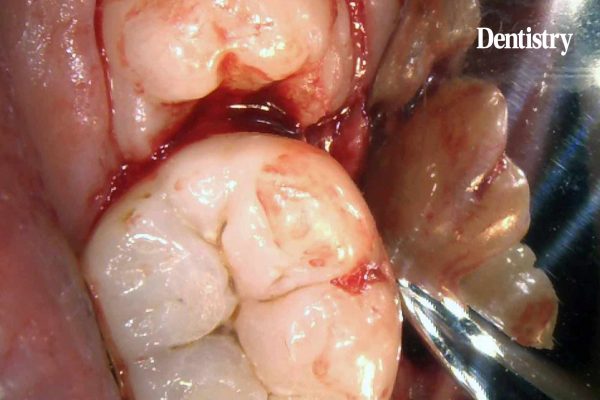Kunal Shah and Sunkanmi Oladeji Olaore demonstrate how integral the W&H Implantmed Plus surgical unit was to the successful extraction of their patient’s wisdom teeth in the lower jaw.
A 34-year-old female patient attended the practice for a routine examination. Although she was fit and healthy with no medical issues, her lower wisdom teeth were mesio-angularly impacted. This meant she suffered from recurrent pericoronitis.
Before she decided on extraction of her lower wisdom teeth, treatment options were discussed with the patient. This included the option of no treatment.
When it comes to wisdom tooth extractions, we conduct a very rigorous consent process, owing to the fact that the inferior dental nerve (IDN) travels along the lower jaw. We, therefore, like to make sure that the patient is aware of the surgical risks involved with the procedure. Even though they are minimised wherever possible. This includes temporary or permanent loss of feeling in relation to which side of the jaw the nerve runs through.
Treatment planning
During the initial assessment of the patient, an OPG was taken to evaluate the position, angulation and root anatomy of the wisdom teeth, as well as where the IDN was located in the lower jaw. The trunk of the IDN was also assessed in relation to the roots of the wisdom teeth.
The radiograph was discussed with the patient so that she could visualise the treatment area and to facilitate explanation of the extraction process.
Treatment commenced once she provided informed consent.
Extraction
Typically, whenever we are extracting two teeth – especially in the lower jaw – we focus entirely on one tooth before moving onto the other.
The procedure began with an inferior dental alveolar block injection of local anaesthetic – consisting of 4% articaine hydrochloride with 1:100,000 adrenaline and 2% lignocaine hydrochloride with 1:100,000 adrenaline – to numb the area around the lower left wisdom tooth.
At this time, we confirmed that the tooth was partially erupted and mesio-angularly impacted.
A surgical flap design was mapped out. This aided visualisation and determined how we would undertake the procedure.
We were fortunate to have an Implantmed Plus with surgical handpieces from W&H. A full mucoperiosteal flap was raised with a distal reliving incision.
Decoronating
After raising this flap so that we could see the bone and the tooth, a precise buccal bone gutter was drilled around the wisdom tooth.
The plan was to section the tooth by initially decoronating it. This was performed to allow easier sectioning of the tooth roots due to the bulbosity of the tooth itself, which was first determined radiographically.
Upon removing the crown and sectioning the tooth roots, we used elevators to slowly lift it out with the roots.
Suturing
We then debrided and irrigated the socket before suturing the surgical site. We used a combination of a modified sling suture and simple interrupted PGA Resoquick resorbable sutures. The reason for employing these sutures and raising a surgical flap in the way that we did was to ensure maximum access and visualisation of the surgical site.
The suturing technique enabled us to approximate the wound together and obtain a favourable seal around the distal end of the lower left second molar in order to reduce the risk of recession.
The patient was provided a short break before the procedure was repeated on the lower right wisdom tooth. We utilised the same surgical techniques.
Accessing the surgical site was challenging but overcoming this comes down to the technique used. Also, the experience of the clinician. The more experience you gain in this type of treatment, the more you develop your understanding of how to orientate the patient’s head, achieve the most suitable angle for extraction, and communicate with your dental nurse so that they are able to effectively support you during the surgery.
Review
The key to ensuring efficient extraction of a wisdom tooth is to obtain appropriate consent. Carry out sufficient treatment planning and use the correct tools – from the surgical unit and handpieces, to the elevators and cheek retractors. This enabled us to complete treatment with ease and the patient was very happy with the final result. In fact, she was surprised at how quick and straightforward the overall process was.
In terms of the Implantmed Plus, we had the motor pre-set to an oral surgery programme with the S-11 L optic handpiece and wireless foot control. The surgical handpiece itself is ergonomic and lightweight. The advantage of the wireless foot control – especially with a surgical case like this – is that it makes it easier to move from one side of a patient to the other to perform treatment. Not having cables in the way was really useful.
There are a number of reasons why we would recommend the Implantmed Plus to other clinicians. Firstly, the unit is compact and looks really professional. Secondly, it has a simple design and is very easy for a dental nurse to set up. Thirdly, the Implantmed is already preloaded with programmes. This makes it straightforward to follow, depending on what setting you have the unit on.
As an implant dentist, it’s extremely useful that you don’t have to keep changing the pre-settings on the Implantmed. It’s just a neat machine. We like the fact that the S-11 L handpiece is optic. It ensures maximum illumination of the treatment site for enhanced visualisation.
This article first appeared in Clinical Dentistry magazine. Sign up to receive the latest issue of Clinical Dentistry magazine here.


